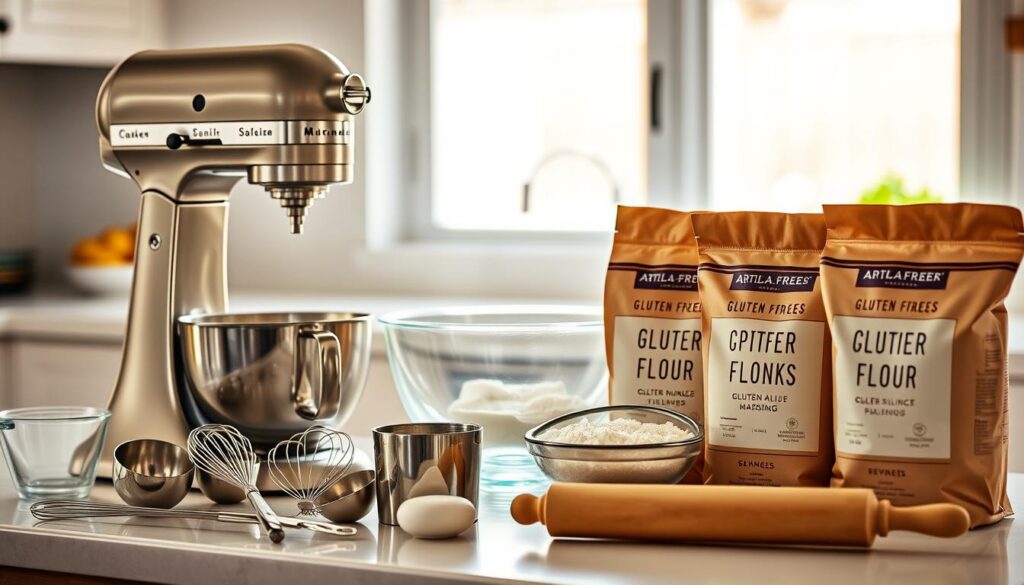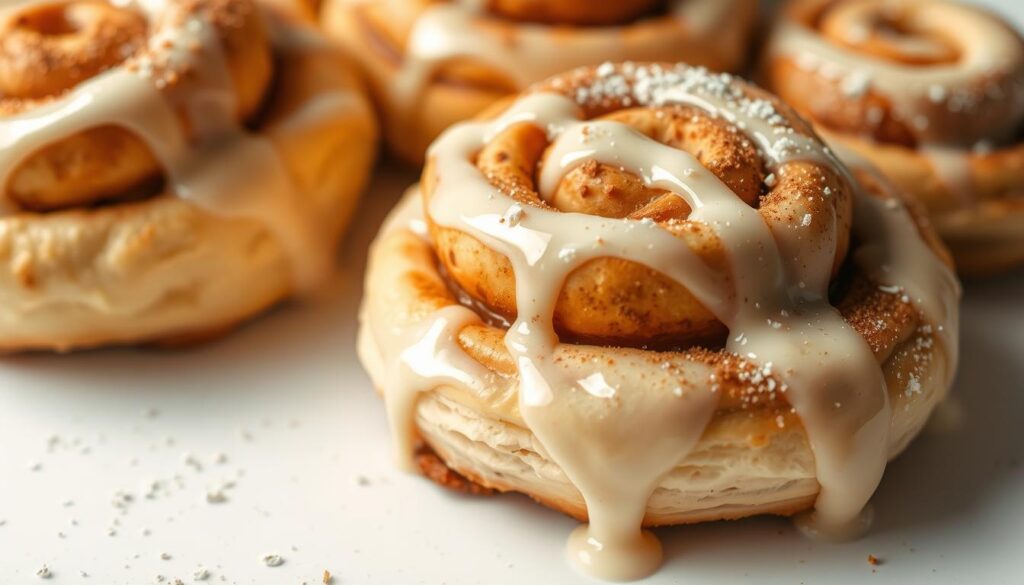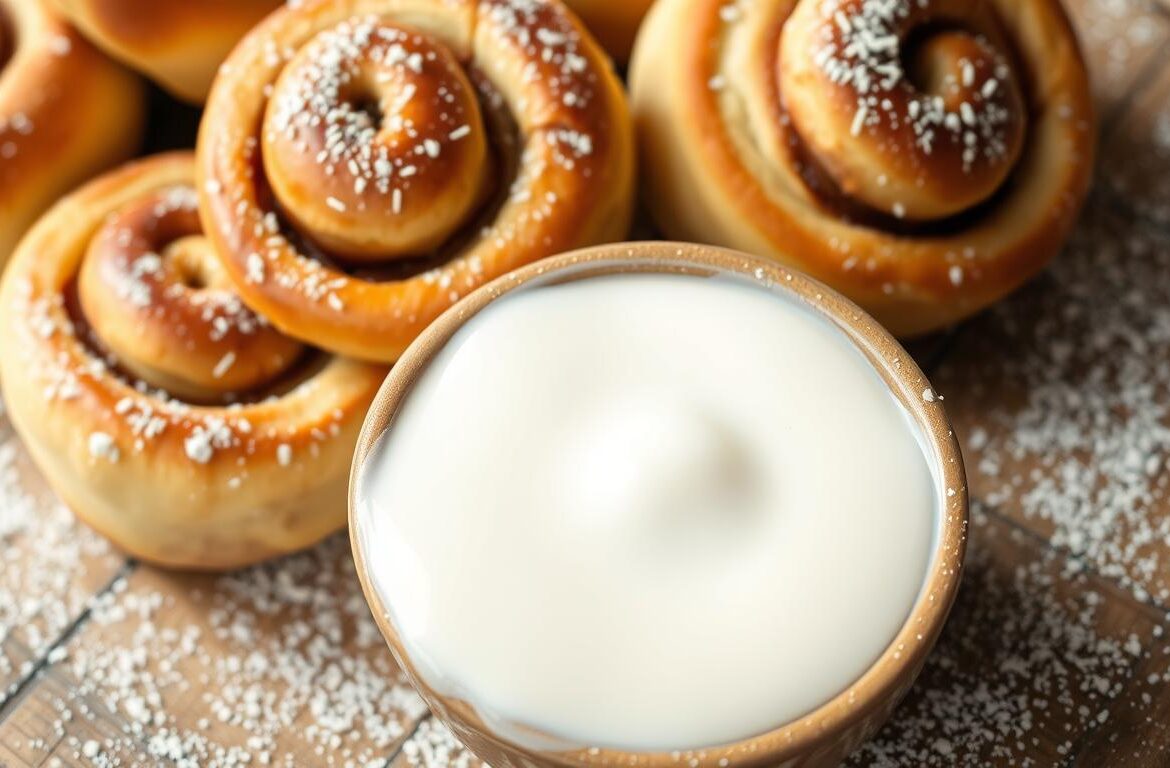Imagine waking up on a lazy Sunday morning. The sweet aroma of freshly baked cinnamon rolls fills the air. This is possible without worrying about dietary restrictions. For those with gluten intolerance, enjoying this sweet treat was once hard. But now, you can make delicious homemade cinnamon rolls that everyone can love.
Baking gluten-free cinnamon rolls at home is easier than you think. With a few simple tips, you can get perfect results. In this article, we’ll show you how to make these tasty treats. We’ll cover everything from choosing the right ingredients to mastering the baking technique.
Key Takeaways
- Learn how to make delicious gluten-free cinnamon rolls at home.
- Discover the best ingredients for gluten-free baking.
- Master the technique for baking perfect cinnamon rolls.
- Understand the benefits of making homemade cinnamon rolls.
- Get tips for customizing your gluten-free cinnamon rolls.
Understanding the Challenges of Gluten-Free Baking
Gluten-free baking is tough, mainly when making homemade cinnamon rolls. Gluten is key in regular baking. It gives dough structure and makes it stretchy.
Why Traditional Cinnamon Rolls Rely on Gluten
Traditional cinnamon rolls need gluten for their chewy feel and to rise. Gluten-free flours don’t stretch like gluten does. This makes it hard to get the same texture.
Common Issues with Gluten-Free Dough
Gluten-free dough can be crumbly, dense, or too wet. Problems include:
- Dough that’s hard to roll out
- Poor texture after baking
- Inconsistent rising
Benefits of Making Your Own Gluten-Free Treats
Despite the hurdles, making gluten-free treats yourself has perks. You can pick the ingredients and adjust the recipe to fit your diet. You can try different flours and ingredients to find the best mix.
Essential Ingredients for Perfect Gluten-Free Cinnamon Rolls
When baking gluten-free cinnamon rolls, the right ingredients are key. You want to pick items that fit your diet and make your rolls taste great and feel soft.
Best Gluten-Free Flour Blends to Use
Finding the best gluten-free flour blend is important. Look for mixes with rice flour, potato starch, and tapioca flour. Brands like Bob’s Red Mill and Pamela’s Products are good choices.
Xanthan Gum and Other Binding Agents
Xanthan gum is a key ingredient in gluten-free baking. It helps your cinnamon rolls hold their shape better. You can also use guar gum or psyllium husk as substitutes.
Sweeteners and Flavorings
For sweetness, you can use sugar, brown sugar, honey, or maple syrup. Cinnamon is the main flavor, but nutmeg or cardamom can add more taste.
Dairy and Egg Alternatives for Various Dietary Needs
If you’re allergic to dairy, try almond milk, soy milk, or coconut milk. For eggs, flaxseed or chia seeds mixed with water work well as substitutes.
| Ingredient | Traditional | Gluten-Free Alternative |
|---|---|---|
| Flour | Wheat Flour | Gluten-Free Flour Blend |
| Milk | Dairy Milk | Almond Milk, Soy Milk |
| Egg | Chicken Egg | Flaxseed, Chia Seeds |
Equipment and Preparation Tips
Making gluten-free cinnamon rolls at home is easy with the right tools and techniques. “The right tools make all the difference in baking,” say many bakers. You need the right equipment and a tidy kitchen for success.
Must-Have Tools for Success
You’ll need some essential tools for gluten-free cinnamon rolls. A stand mixer or a strong hand mixer is key for mixing the dough. You’ll also need a large mixing bowl and a dough scraper for the sticky dough.
A pastry brush is needed for the egg wash or melted butter on the rolls.
Setting Up Your Kitchen for Efficiency
Being efficient in the kitchen helps a lot. Clear your workspace and organize your tools and ingredients. This makes you work better and avoids mistakes.
“A cluttered kitchen is a baker’s worst enemy,”

Measuring Techniques for Gluten-Free Baking
Measuring ingredients right is key in gluten-free baking. Use a digital scale for weight measurements, not volume. This is more precise. Make sure you have the right measuring cups for dry and liquid ingredients.
Step-by-Step Gluten-Free Cinnamon Rolls Recipe
Let’s start making gluten-free cinnamon rolls. We’ll cover making the dough, the cinnamon filling, and proofing before baking.
Making the Perfect Dough
Creating the dough is key. It involves several steps:
Mixing Dry Ingredients
First, mix gluten-free flour, sugar, and other dry ingredients in a big bowl. Use 1 1/2 cups of gluten-free flour, 1/4 cup of granulated sugar, and 2 teaspoons of salt. Make sure they’re well mixed.
Incorporating Wet Ingredients
Next, whisk together 1/2 cup of warm milk, 2 large eggs, and 2 tablespoons of melted butter. Add these to the dry ingredients slowly. Mix until a dough forms.
Kneading and Resting the Dough
Knead the dough for 10 minutes until it’s smooth. Then, let it rest in a warm place for 1 hour. It should double in size.
Creating the Cinnamon Filling
While the dough rests, make the cinnamon filling. Mix 1/2 cup of granulated sugar and 2 tablespoons of ground cinnamon in a bowl. Add 1/4 cup of melted butter and stir until it’s crumbly.
Rolling and Cutting Techniques
After the dough rises, roll it out to 1/4 inch thick. Spread the cinnamon filling over it, leaving a border. Roll it into a log and cut into 12 equal pieces.
Proofing Your Rolls Before Baking
Put the rolls in a greased baking dish, leaving space for them to grow. Cover with a cloth and let them proof in a warm place for 1 hour. They should double in size.

By following these steps, you’ll make delicious gluten-free cinnamon rolls. Enjoy the baking process and the tasty results!
Baking and Troubleshooting Guide
To get the perfect bake, knowing the best baking temperature and time is key for your gluten-free cinnamon rolls. This info helps you avoid common mistakes. It ensures your rolls are delicious.
Optimal Baking Temperature and Time
Heat your oven to 375°F (190°C). The baking time depends on your rolls’ size. But usually, bake for 18-20 minutes, or until they’re golden. Watch them closely to avoid overcooking.
Common Problems and Solutions
Even with careful planning, problems can happen. Here are some common issues and how to fix them:
- Crumbly Dough: This might be because of not enough binding agents. Add a bit more xanthan gum to your dough.
- Rolls That Won’t Rise: Make sure your yeast is fresh and your dough is proofed in a warm, draft-free spot.
- Dry Texture: Overmixing or baking too long can make them dry. Mix your dough just until it comes together. And watch your rolls while they bake.
Dealing with Crumbly Dough
If your dough is too crumbly, it might lack moisture or have too much gluten-free flour. Adding more liquid or eggs can help.
Fixing Rolls That Won’t Rise
Check your yeast’s expiration date. Also, make sure your proofing area is at the right temperature.
Preventing Dry Texture
To avoid dryness, don’t overbake your rolls. Check them often towards the end of baking.
How to Tell When They’re Done
Your homemade cinnamon rolls are ready when they’re golden on top and sound hollow when tapped. Let them cool a bit before serving.
Enjoying Your Homemade Gluten-Free Treats
Now that you’ve baked your gluten-free cinnamon rolls, it’s time to enjoy them. Top your rolls with cream cheese frosting, caramel drizzle, or powdered sugar. This will make your sweet breakfasts even better.
Keep your gluten-free baking fresh by storing your rolls in an airtight container. Store them at room temperature for up to three days or freeze for longer. Serve them with fresh fruit, yogurt, or scrambled eggs for a tasty breakfast or brunch.
Try different toppings and serving ideas to enjoy your homemade cinnamon rolls more. Share your freshly baked treats with family and friends. Enjoy the joy of making delicious, gluten-free goodies in your own kitchen.

